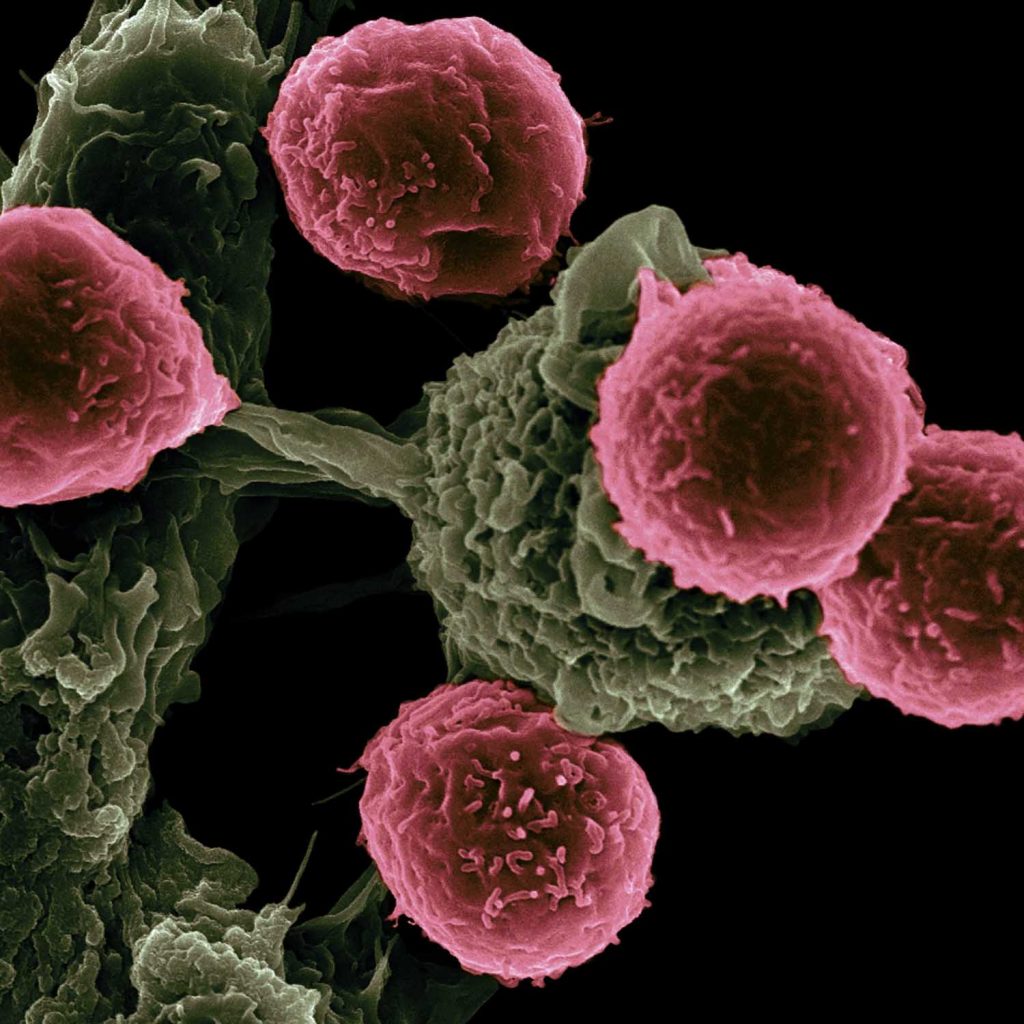Acute Lymphocytic Leukaemia
Acute lymphocytic leukaemia (ALL) is a cancer of the blood in which too many lymphocytes, a type of white blood cell, are produced by the bone marrow and by organs of the lymph system.
Acute Myelogenous Leukaemia
Acute myelogenous leukaemia (AML) is a cancer of the blood in which too many granulocytes, a type of white blood cell, are produced in the bone marrow.
Adrenal Tumors / Pheochromocytoma
Tumors of the adrenal glands can cause many problems by excess secretion of certain adrenal-produced hormones, most often resulting in high blood pressure, which can be extreme.
Basal Cell Carcinoma
Basal cell cancer, sometimes called non-melanoma skin cancer, usually appears as a small, fleshy bump or nodule on the head, neck, or hands. Occasionally, these nodules appear on the trunk of the body, usually as flat growths
Basal Cell Nevus Syndrome (Gorlin Syndrome)
Basal cell nevus syndrome is caused by a tumor suppressor gene, called PTCH, located on chromosome 9. Mutations in this gene may increase the risk of ovarian cancer.
Biliary Cirrhosis / Bile Duct Cancer
Biliary cirrhosis is a rare form of liver cirrhosis, caused by disease or defects of the bile ducts. Symptoms usually include cholestasis (accumulation of bile in the liver). There are two types of biliary cirrhosis: Primary biliary cirrhosis – inflammation and destruction of bile ducts in the liver. Secondary biliary cirrhosis – results from prolonged bile duct obstruction or narrowing or closure of the bile duct.
Bladder Cancer
Bladder cancer occurs when there are abnormal, cancerous cells growing in the bladder.
Bone Cancers
There are many bone cancers that require clinical care by a physician or other health care professional. Listed in the directory below are some, for which we have provided a brief overview.
Brain Tumors
A brain tumor is an abnormal growth of tissue in the brain. The tumor can either originate in the brain itself, or come from another part of the body and travel to the brain (metastasize). Brain tumors may be classified as either benign (non-cancerous) or malignant (cancerous), depending on their behavior.
Breast Cancer in Men
Breast cancer in men is a rare condition in which certain cells in the breast become abnormal and multiply without control to form a tumor
Cardiac Sarcoma
Cardiac sarcoma is a type of tumor that occurs in the heart. Cardiac sarcoma is a primary malignant (cancerous) tumor.
Cervical Cancer
If abnormal cells on the surface of the cervix spread deeper into the cervix, or to other tissues or organs, the disease is then called cervical cancer, or invasive cervical cancer.
Chronic Lymphocytic Leukaemia
Chronic lymphocytic leukaemia (CLL) is a cancer of the blood in which too many lymphocytes, a type of white blood cell, are produced by the bone marrow and by organs of the lymph system
Chronic Myelogenous Leukaemia
Chronic myelogenous leukaemia (CML) is a cancer of the blood in which too many granulocytes, a type of white blood cell, are produced in the bone marrow.
Cowden Syndrome
The risk for breast cancer, gastrointestinal cancers, and thyroid cancer is increased with Cowden syndrome, a rare autosomal dominant disorder that is also associated with a number of specific noncancerous features
Cutaneous T-Cell Lymphoma
Cutaneous T-cell lymphoma is a disease caused when T-lymphocytes become malignant and affect the skin. T-lymphocytes are the infection-fighting white blood cells in the lymph system that kill harmful bacteria in the body, among other things.

Endometrial Cancer
Cancer of the endometrium, the most common cancer of the female reproductive organs, is a disease in which malignant (cancerous) cells are found in the endometrium. Endometrioid cancer is a specific type of endometrial cancer.
Oesophageal Cancer
Oesophageal cancer is cancer that develops in the oesophagus, the muscular tube that connects the throat to the stomach
Generalized Exfoliative Dermatitis
Generalized exfoliative dermatitis is a severe inflammation of the entire skin surface due to a reaction to certain drugs, or as a result of complications from another skin condition.
Hereditary Breast Ovarian Cancer Syndrome (BRCA1 / BRCA2)
Hereditary breast ovarian cancer syndrome is an abnormal version of the gene BRCA1 or BRCA2, which increases a person’s risk of developing various types of cancer
Kidney Cancer (Condition)
Kidney cancer begins in the kidneys – two large, bean-shaped organs – one located to the left, and the other to the right of the backbone.
Laryngeal Cancer (Cancer of the Larynx)
Laryngeal cancer includes cancerous cells found in any part of the larynx – the glottis, the supraglottis, or the subglottis
Liver Tumors
Tumors are abnormal masses of tissue that form when cells begin to reproduce at an increased rate. The liver can grow both non-cancerous (benign) and cancerous (malignant) tumors
Lung Cancer (Condition)
Lung cancer is cancer that usually starts in the lining of the bronchi (the main airways of the lungs), but can also begin in other areas of the respiratory system, including the trachea, bronchioles, or alveoli
Lymphedema Following a Mastectomy
Whenever the normal drainage pattern in the lymph nodes is disturbed or damaged (often during surgery to remove the lymph nodes), swelling of the arm may occur. Radiation may also cause swelling of the arm. This swelling of the arm, caused by an abnormal collection of too much fluid, is called lymphedema.
Melanoma
Melanoma is a disease of the skin in which cancer cells are found in the melanocytes, the cells that produce color in the skin or pigment known as melanin.
Merkel Cell Cancer
Merkel cell cancer is also known as neuroendocrine cancer of the skin, or trabecular cancer.
Non-Hodgkin's Lymphoma
Non-Hodgkin disease is a type of lymphoma, which is a cancer in the lymphatic system.
Oral Cancer (Condition)
Oral cancer is cancer found in the oral cavity (the mouth area) and the oropharynx (the throat area at the back of the mouth).
Osteosarcoma
Osteosarcoma is a type of bone cancer that develops in the osteoblast cells that form the outer covering of bone.
Other Types of Skin Cancer: Kaposi's Sarcoma
Kaposi’s sarcoma is a skin cancer that starts in the skin’s blood vessels. Kaposi’s sarcoma comes in two forms: a slow-growing form, and a more aggressive, faster-spreading form.

Ovarian Cancer
Ovarian cancer is a disease in which malignant cells are found in an ovary.
Ovarian Cancer and Hereditary Nonpolyposis Colon Cancer (HNPCC)
The risk for ovarian cancer is increased with hereditary nonpolyposis colon cancer (HNPCC), an autosomal dominant cancer genetic syndrome.
Peutz-Jeghers Syndrome
The risk for breast and ovarian cancer is increased with Peutz-Jeghers syndrome (PJS), a rare early-onset autosomal dominant disorder, associated with specific physical characteristics in addition to increased cancer risks
Prostate Cancer (Condition)
Early prostate cancer may not present any symptoms and can only be found with regular prostate examinations by your physician
Skin Cancer (Condition)
Skin cancer is a malignant tumor that grows in the skin cells and accounts for more than 50 percent of all cancers
Squamous Cell Carcinoma
Squamous cell skin cancer (sometimes referred to as non-melanoma carcinoma) may appear as nodules, or as red, scaly patches of skin.
Stomach Cancer
Stomach cancer, also known as gastric cancer, is cancer that starts in any part of the stomach.
Testicular Cancer
Cancer that develops in a testicle is called testicular cancer.
Uterine Cancer
Cancers that occur in each part of the uterus have their own names, such as cervical cancer or endometrial cancer, but are sometimes broadly defined as uterine cancer because the structure is part of the uterus
Vaginal Cancer
Cancer of the vagina, a rare kind of cancer in women, is a disease in which malignant cells are found in the tissues of the vagina
Vulvar Cancer
Vulvar cancer is a malignancy that can occur on any part of the external organs, but most often affects the labia majora or labia minora.
